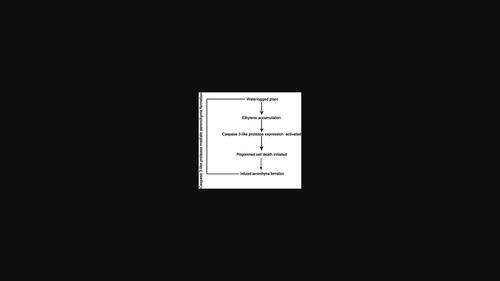当前位置:
X-MOL 学术
›
Microsc. Res. Tech.
›
论文详情
Our official English website, www.x-mol.net, welcomes your feedback! (Note: you will need to create a separate account there.)
Caspase 3-like protease is involved in ethylene-induced programmed cell death during aerenchyma formation in Helianthus annuus stem
Microscopy Research and Technique ( IF 2.5 ) Pub Date : 2022-08-19 , DOI: 10.1002/jemt.24222 Xi-Lu Ni 1, 2, 3 , Hui Hou 1, 2 , Qinmi Xie 1, 2 , Haiying Zhang 1, 2 , Peixuan Yan 4 , Yingze Lv 4
Microscopy Research and Technique ( IF 2.5 ) Pub Date : 2022-08-19 , DOI: 10.1002/jemt.24222 Xi-Lu Ni 1, 2, 3 , Hui Hou 1, 2 , Qinmi Xie 1, 2 , Haiying Zhang 1, 2 , Peixuan Yan 4 , Yingze Lv 4
Affiliation

|
Previous research has reported that hypoxic conditions and ethylene treatments greatly trigger programmed cell death (PCD) occurrence and induce the formation of aerenchyma to adapt stress environment in Helianthus annuus stem. Caspase 3-like protease (CLP) as regulatory signals, also be involved in the process of PCD to adapt the low oxygen environment. However, the relationships between ethylene and CLP have seldom been reported. Herein, To understand the regulatory role of ethylene and CLP signaling molecules in aerenchyma formation, we investigated the effects of exogenous ethephon (ET), ethylene perception inhibitor 1-methylcyclopropene (1-MCP), and the treatment of 1-MCP + ET on morphological, physiological characteristics and aerenchyma formation in H. annuus stem. The results showed that lysigenous aerenchyma formation in H. annuus stem is induced by ET, and immunohistochemistry assay indicate CLP activity is raised at the formation stage of aerenchyma formation, and decreased at the expanding phase of aerenchyma formation. Western blotting illustrate the expression of CLP is also increased within 8 h after ethylene signaling inducing aerenchyma formation, and the activities of CLP are higher in ET treated seedlings than the control and 1-MCP treated seedlings. The same phenomenon was also observed by caspase-3 activity assay. These results revealed there is a causal and interdependent relationship between ET and CLP signaling during the process of aerenchyma formation, which regulating PCD initiation in H. annuus stem.
中文翻译:

Caspase 3 样蛋白酶参与向日葵茎部通气组织形成过程中乙烯诱导的程序性细胞死亡
先前的研究报道,缺氧条件和乙烯处理极大地触发了程序性细胞死亡 (PCD) 的发生,并诱导了气组织的形成以适应向日葵茎中的应激环境。Caspase 3样蛋白酶(CLP)作为调节信号,也参与了PCD适应低氧环境的过程。然而,乙烯与 CLP 之间的关系却鲜有报道。在此,为了了解乙烯和 CLP 信号分子在通气组织形成中的调节作用,我们研究了外源性乙烯利 (ET)、乙烯感知抑制剂 1-甲基环丙烯 (1-MCP) 以及 1-MCP + ET 对H. annuus的形态、生理特征和通气组织形成干。结果表明,ET诱导了青蒿茎的溶源性通气组织形成,免疫组化分析表明CLP活性在通气组织形成阶段升高,在通气组织形成扩大阶段降低。Western印迹表明,乙烯信号诱导通气组织形成后8小时内CLP的表达也增加,并且ET处理的幼苗中CLP的活性高于对照和1-MCP处理的幼苗。通过 caspase-3 活性测定也观察到相同的现象。这些结果表明,在通气组织形成过程中,ET 和 CLP 信号之间存在因果关系和相互依赖的关系,从而调节H. annuus茎中 PCD 的起始。
更新日期:2022-08-19
中文翻译:

Caspase 3 样蛋白酶参与向日葵茎部通气组织形成过程中乙烯诱导的程序性细胞死亡
先前的研究报道,缺氧条件和乙烯处理极大地触发了程序性细胞死亡 (PCD) 的发生,并诱导了气组织的形成以适应向日葵茎中的应激环境。Caspase 3样蛋白酶(CLP)作为调节信号,也参与了PCD适应低氧环境的过程。然而,乙烯与 CLP 之间的关系却鲜有报道。在此,为了了解乙烯和 CLP 信号分子在通气组织形成中的调节作用,我们研究了外源性乙烯利 (ET)、乙烯感知抑制剂 1-甲基环丙烯 (1-MCP) 以及 1-MCP + ET 对H. annuus的形态、生理特征和通气组织形成干。结果表明,ET诱导了青蒿茎的溶源性通气组织形成,免疫组化分析表明CLP活性在通气组织形成阶段升高,在通气组织形成扩大阶段降低。Western印迹表明,乙烯信号诱导通气组织形成后8小时内CLP的表达也增加,并且ET处理的幼苗中CLP的活性高于对照和1-MCP处理的幼苗。通过 caspase-3 活性测定也观察到相同的现象。这些结果表明,在通气组织形成过程中,ET 和 CLP 信号之间存在因果关系和相互依赖的关系,从而调节H. annuus茎中 PCD 的起始。


























 京公网安备 11010802027423号
京公网安备 11010802027423号